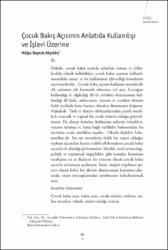| dc.contributor.author | Bayrak Akyıldız, Hülya | |
| dc.date.accessioned | 2019-10-19T16:03:50Z | |
| dc.date.available | 2019-10-19T16:03:50Z | |
| dc.date.issued | 2016 | |
| dc.identifier.issn | 1301-0549 | |
| dc.identifier.uri | http://www.trdizin.gov.tr/publication/paper/detail/TWpBek1qTXpNdz09 | |
| dc.identifier.uri | https://hdl.handle.net/11421/14240 | |
| dc.description.abstract | Makale, çocuk bakış açısıyla anlatılan roman ve öykülerdeki teknik farklılıkları, çocuk bakış açısının kullanılmasındaki amacı ve bu kullanımın işlevselliği konularını incelemektedir. Çocuk bakış açısını kullanan metinlerde dil, anlamın çift katmanlı olmasına yol açar. Çocuğun kullandığı ve algıladığı dil ile yetişkin okuyucunun kullandığı dil farkı, anlatıcının, yazarın ve yetişkin okurun farklı kodlarla karşı karşıya olmaları durumunu doğurur. Makalede Türk ve dünya edebiyatlarından çeşitli örneklerle tematik ve yapısal bir ortak örüntü olduğu gösterilmiştir. Ele alınan konular, kullanılan anlatım teknikleri, yazarın tutumu ve buna bağlı özellikler bakımından bu metinler ortak nitelikler taşırlar. Okurla ilişkileri bakımından da bu tür metinlerin farklı bir yapısı olduğu; toplum açısından hassas olabilecek konuların çocuk bakış açısıyla ele alındığı gözlenmiştir. Irkçılık, sınıf ayrımcılığı, politik ve toplumsal özgürlükler gibi konular, konunun taraflarını en az dışlayan bir yöntem olarak çocuk bakış açısıyla tartışmaya açılmıştır. Yazar, empati yapılması görece olarak kolay bir aktörü okuyucunun karşısına çıkararak, onun önyargılarından sıyrılmasını kolaylaştırmak ister | en_US |
| dc.description.abstract | This article examines technical features of novels and short stories narrated from a child's point of view and attempts to point out the goal of writers who adopt this perspective , and the functionality of its use. In texts whe-re a child's point of view is presented, the use of language leads to a double-layered structure of meaning. Differen-ces between the language that the child uses and perceives and that of the adult reader lead the child-narrator, writer and adult reader to be face-to-face with different codes. In the article it is shown through references to both Turkish and World Literature that there is a common thematical and structural pattern in texts narrated from the child's point of view. These texts have common features in terms of issues that are addressed, narrative techniques that are used, writer's attitudes and other features related to this. The texts also have different types of relations with the reader as they deal with relatively delicate issues from a child's point of view. In order to keep distractions from the main issue to a minimum, the child's point of view is used to consider issues such as racism, class discriminati-on, and political and social freedom. The authors' inten-tion is for readers to reduce their biases by making them encounter an actor with whom it is relatively easier to empathize. | en_US |
| dc.language.iso | tur | en_US |
| dc.rights | info:eu-repo/semantics/openAccess | en_US |
| dc.subject | Sosyal Bilimler | en_US |
| dc.subject | Disiplinler Arası | en_US |
| dc.title | Çocuk Bakış Açısının Anlatıda Kullanılışı ve İşlevi Üzerine | en_US |
| dc.title.alternative | the Functionality of Child's Perspective as a Narrative Technique | en_US |
| dc.type | article | en_US |
| dc.relation.journal | Bilig / Türk Dünyası Sosyal Bilimler Dergisi | en_US |
| dc.contributor.department | Anadolu Üniversitesi, Edebiyat Fakültesi, Türk Dili ve Edebiyatı Bölümü | en_US |
| dc.identifier.volume | 2016 | en_US |
| dc.identifier.issue | 78 | en_US |
| dc.identifier.startpage | 95 | en_US |
| dc.identifier.endpage | 116 | en_US |
| dc.relation.publicationcategory | Makale - Ulusal Hakemli Dergi - Kurum Öğretim Elemanı | en_US] |
| dc.contributor.institutionauthor | Bayrak Akyıldız, Hülya | |


















